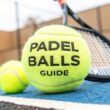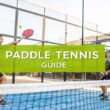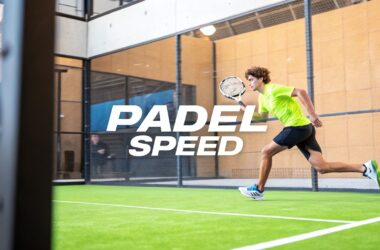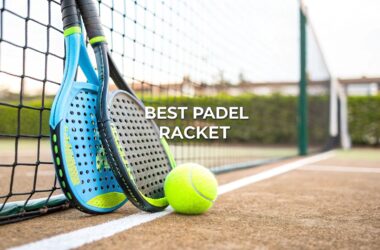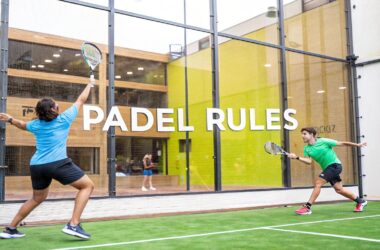When you start looking into building a padel court, you quickly realize you’re dealing with a specialized field. The companies responsible for designing, manufacturing, and installing these courts—whether for clubs, private homes, or commercial spots—are known as padel court builders.
This isn't just a minor construction trend; it's a massive shift in recreational sports, opening up huge opportunities for investors and facility owners alike.
Understanding the Padel Court Construction Boom
So, why is padel exploding in popularity? It boils down to a perfect mix of being easy to learn and incredibly social. Unlike tennis, which can have a pretty steep learning curve, pretty much anyone can pick up a padel racket and have a great time from their very first game. It's this low barrier to entry that makes it a hit with players of all ages and fitness levels.
The social vibe is the other big piece of the puzzle. You play doubles on a smaller, enclosed court, which means you're constantly talking and working with your partner. It’s as much a social hangout as it is a workout. That’s exactly why clubs, residential communities, and even corporate campuses are scrambling to add courts.
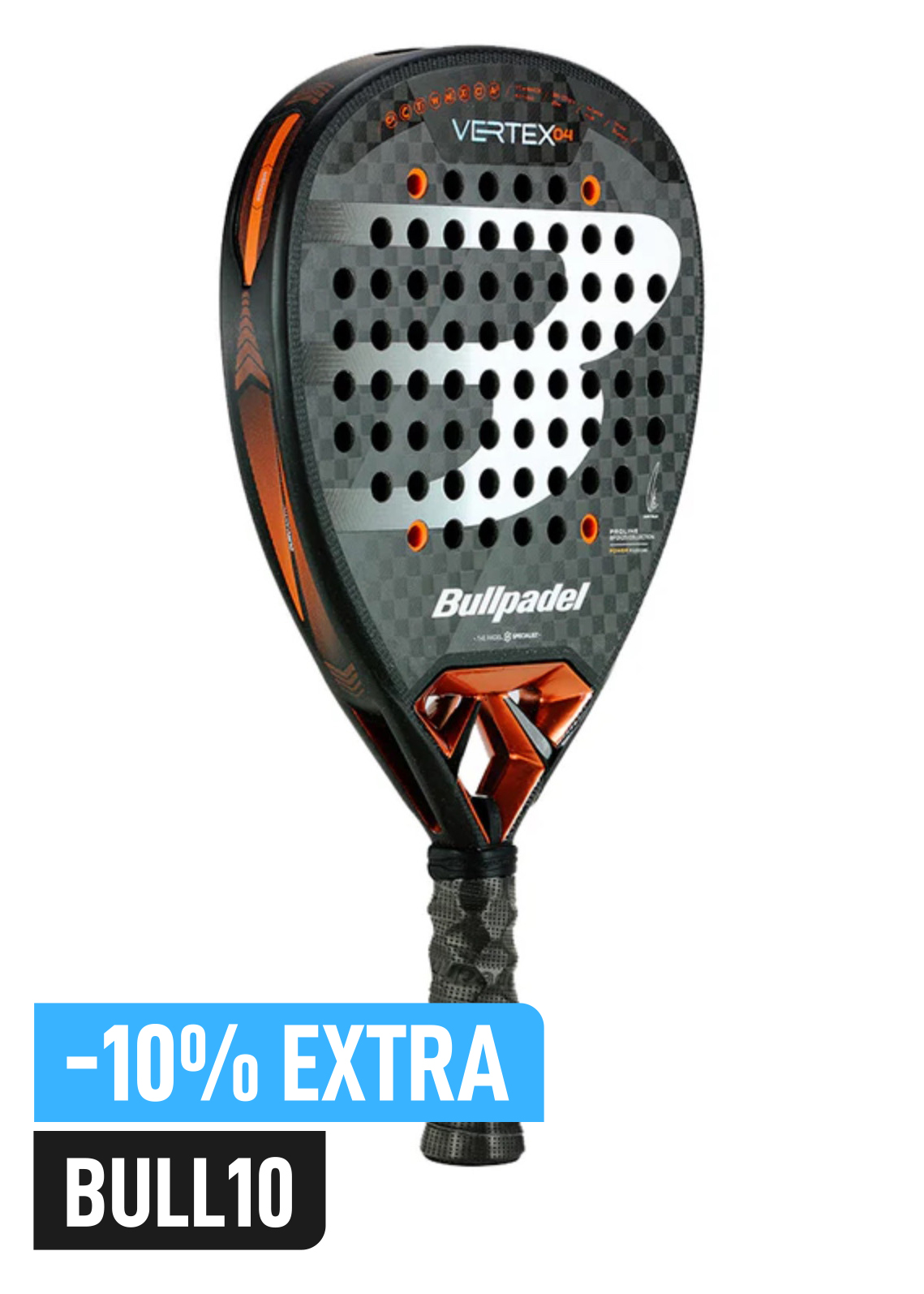
Buy the best padel gear to level up your next game!
CHECK OUT this deal from Padel Market!Get ready to take your game to the next level with the latest padel gear from Padel Market! Fast EU and Worldwide Shipping
This surge in demand has created a parallel boom in the construction market. Experienced padel court builders are in high demand, tasked with keeping up with a rapidly expanding industry. They’re not just building sports facilities anymore; they're creating lively social hubs that deliver a serious return on investment for their owners.
The Market Opportunity Explained
The numbers behind this boom are hard to ignore. The global padel court market was valued at around USD 1.2 billion in 2024 and is on track to more than double, expected to blow past USD 2.5 billion by 2033.
That's a compound annual growth rate (CAGR) of 8.9%, which points to sustained, long-term investment in the sport. You can explore more data on these market projections and see the full analysis for yourself.
This rapid growth has opened a strategic window for anyone thinking about a padel project. Here’s what’s driving this opportunity:
- High Occupancy Rates: New courts fill up fast. This means a quick return on your investment through court rentals and memberships.
- Diversification for Existing Clubs: Tennis clubs, gyms, and golf courses are adding padel to pull in new members and keep existing ones happy by offering something new.
- Real Estate Value: For housing developments and hotels, on-site padel courts have become a premium amenity that seriously boosts property value and appeal.
The current market isn't just about building courts; it's about capitalizing on a cultural phenomenon. The demand is driven by a genuine love for a sport that is fun, social, and accessible to everyone.
Getting a handle on these dynamics is the first step. For investors and developers, the message is clear: the demand is real, the market is growing, and now is the time to team up with a skilled padel court builder. You're not just putting down a playing surface; you're investing in the future of community, fitness, and fun.
How to Vet and Select Your Padel Court Builder
Choosing the right padel court builder is probably the single most important decision you'll make in this entire process. A slick website and a flashy portfolio are nice, but that’s just the starting line. Your project's success truly hinges on finding a partner with proven experience, transparent processes, and the right resources to actually bring your vision to life.
This decision has become more critical than ever, thanks to the sport's explosive growth. With the global court count now soaring past 50,000, the demand for qualified builders has gone through the roof. Just in 2024, a staggering 7,187 new courts were built, marking a massive 17% year-over-year growth that shows no sign of slowing down.
With so many new companies jumping into the construction game, your job is to tell the seasoned pros apart from the rookies. A great builder doesn't just assemble a court; they act as your consultant, guiding you through the tricky decisions from ground preparation all the way to the final sign-off.
Look Beyond the Portfolio
A gallery of finished projects is standard, but it doesn't tell you the whole story. You need to dig much deeper to get a real sense of a builder's capabilities. Start by asking about their specific experience with projects like yours.
Building an indoor court in a climate-controlled warehouse, for instance, is a completely different ballgame than constructing an outdoor court that has to stand up to coastal winds and saltwater spray. Ask potential builders for examples of projects that are similar in scope and face the same environmental challenges as yours.
Here are a few essential things to investigate:
- Material Sourcing: Where do they get their turf, tempered glass, and steel? Reputable builders have solid relationships with top-tier suppliers and won't be shy about sharing those details.
- Geographical Experience: Have they built courts in your state or city before? Being familiar with local soil conditions, weather patterns, and—most importantly—building codes can save you from a world of expensive delays.
- Team and Subcontractors: Do they have their own in-house installation crew, or do they farm it out to subcontractors? If they use subs, ask them how they're vetted and managed to guarantee quality.
A builder's portfolio shows you what they've built. Your job is to uncover how they built it and if they can do it again for you.
Asking the Right Questions
Once you've shortlisted a few candidates, it's time to have some serious conversations. Your mission is to get a feel for their expertise, how they communicate, and their whole approach to managing a project. Don't bother with generic questions; they just get you generic answers.
Here’s a quick framework to help you evaluate and compare the builders you're considering. It’s all about finding the right fit, not just the lowest price.
Key Criteria for Evaluating Padel Court Builders
| Evaluation Criteria | What to Look For | Why It Matters |
|---|---|---|
| Technical Expertise | Can they explain the real-world difference between 10mm and 12mm glass for your climate? Or the pros and cons of monofilament vs. fibrillated turf for a high-traffic club? | This shows they understand the fine details and can recommend what you actually need, not just sell a one-size-fits-all package. |
| Logistics & Timelines | Ask for a typical project timeline from signing to completion. How do they plan for potential weather or supply chain delays? | This sets clear expectations and shows you how they handle problems. A real pro will already have backup plans in place. |
| Compliance & Permits | What’s their process for dealing with local building permits and zoning laws? Can they point to past projects where they managed this successfully? | This is non-negotiable. An inexperienced builder can get your project tied up in red tape for months, costing you time and money. |
A structured approach like this helps you move beyond a gut feeling and make a data-driven decision. The best partner will be able to answer these questions confidently and back them up with proof.

Buy the best padel gear to level up your next game!
CHECK OUT this deal from Padel Market!Get ready to take your game to the next level with the latest padel gear from Padel Market! Fast EU and Worldwide Shipping
The Ultimate Litmus Test: Checking References
Finally, whatever you do, never skip checking references. This is your chance to get an unfiltered look at what it’s really like to work with this company. When you talk to past clients, don't just ask if they were "happy."
Instead, ask targeted questions that get to the heart of how the builder performs when things get tough:
- Communication: How responsive was the project manager? Did you get regular, honest updates on progress and any hiccups?
- Budget: How did the final cost stack up against the initial quote? Were there surprise expenses, and if so, how were they handled?
- Timeline: Was the court finished on time? If not, was the reason clearly explained and managed?
- Post-Completion Support: Have you had any issues since the court was finished? How did the builder handle warranty claims or calls for support?
A builder who practically pushes you to call their past clients is confident in their work. Taking the time to do this homework ensures you end up with a true partner, not just a contractor. If you need more guidance, check out our complete guide to padel court construction.
Getting Real About Padel Court Costs
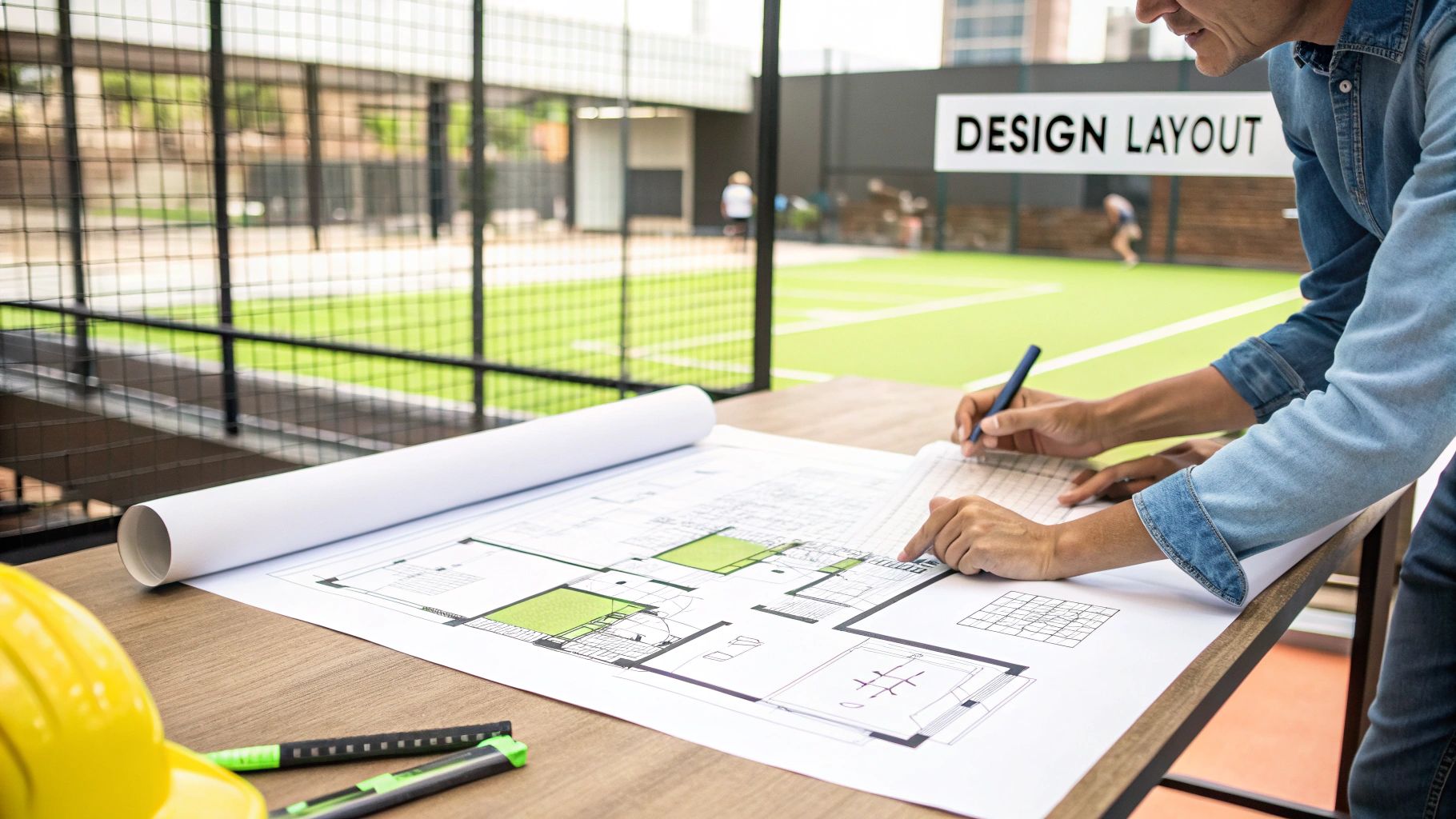
Before you ever break ground, you need a financial game plan that’s locked in. The price a padel court builder quotes you is just the tip of the iceberg. A realistic budget has to cover everything, from the dirt under the court to the lights shining down on it.
Nailing down the full scope of your expenses is what separates a smooth, successful build from one bogged down by surprise bills and stressful delays. The final number hinges on a whole host of variables, and each one makes a dent in your bottom line.
Core Construction Costs: The Big Ticket Items
Your primary costs are the materials and labor that go directly into building the court itself. These are the non-negotiables. But even here, you'll find a massive price range depending on the quality, style, and performance you're after.
A standard outdoor court, for instance, can run you anywhere from $20,000 to $40,000. That ballpark figure usually gets you the steel structure, glass, turf, and a basic lighting setup. But trust me, that's just the starting point.
Here’s a closer look at the key components driving that initial number:
- Foundation and Site Prep: This is literally the groundwork of your project. You're paying for excavation, proper drainage, and pouring a solid, reinforced concrete slab. If your site has tricky terrain or poor soil, this phase alone can become a major expense.
- Court Structure: The frame is the skeleton of your court, typically made of steel or aluminum. A classic, pillar-based structure is your most budget-friendly option. If you want a panoramic court with its stunning, uninterrupted views from fewer, larger glass panels, you’re looking at a premium investment.
- Glass Panels: The industry standard is tempered glass, usually 10mm or 12mm thick. While 10mm works, the 12mm option is tougher, offers a better ball rebound, and just feels more solid—but it comes with a higher price tag.
- Playing Surface: The artificial turf is another place where choices matter. You'll typically decide between monofilament and fibrillated turf, each providing a different feel, bounce, and level of durability. The quality of the turf and the amount of sand infill needed will move the cost needle.
- Lighting System: If you want play to continue after sunset, LED lighting is a must. A standard 4-post system is common, but if you're aiming for high-level competition or broadcasting, you'll want to invest in more advanced, glare-free options, which will definitely bump up the budget.
Uncovering the Hidden Costs
What really catches new project owners off guard are all the "soft costs" and extra expenses that aren't in the builder's initial quote. Ignoring these can blow up your budget fast. Any good padel court builder will help you see these coming, but you need to have them on your radar from day one.
These extra costs are just as vital as the physical court components and have to be part of your total project investment.
Thinking beyond the court itself is critical for financial planning. Landscaping, permits, and professional fees aren't optional extras; they are integral parts of the project's total cost.
Let’s pull back the curtain on these often-overlooked expenses:
- Permits and Architectural Fees: Before a single shovel hits the ground, you need approved plans. This means paying for architectural drawings, structural engineering reports, and local city or county permitting fees. These costs can vary dramatically depending on where you're building.
- Landscaping and Access: A padel court doesn't just appear in a field. Your budget needs to account for pathways, spectator seating areas, fencing, and landscaping to make the court feel like a polished, integrated part of the property.
- Shipping and Logistics: All those heavy materials—glass, steel, rolls of turf—have to get to your site. Freight costs can be substantial, especially if your project is in a remote or hard-to-reach location.
- Amenities and Extras: Are you adding benches for players? A water fountain? Maybe some shaded rest areas? These player-focused amenities make a huge difference in the overall experience but also need to be factored into the budget.
When you're looking at how to pay for it all, it's worth understanding what funding is available; for example, looking into a Merchant Cash Advance for your construction business could be a viable route.
By creating a complete budget that covers both the core build and all these "hidden" costs, you're setting your project up for a win. For a more detailed breakdown of the numbers, check out our deep dive into padel court construction cost.
Key Design Choices for a Superior Playing Experience
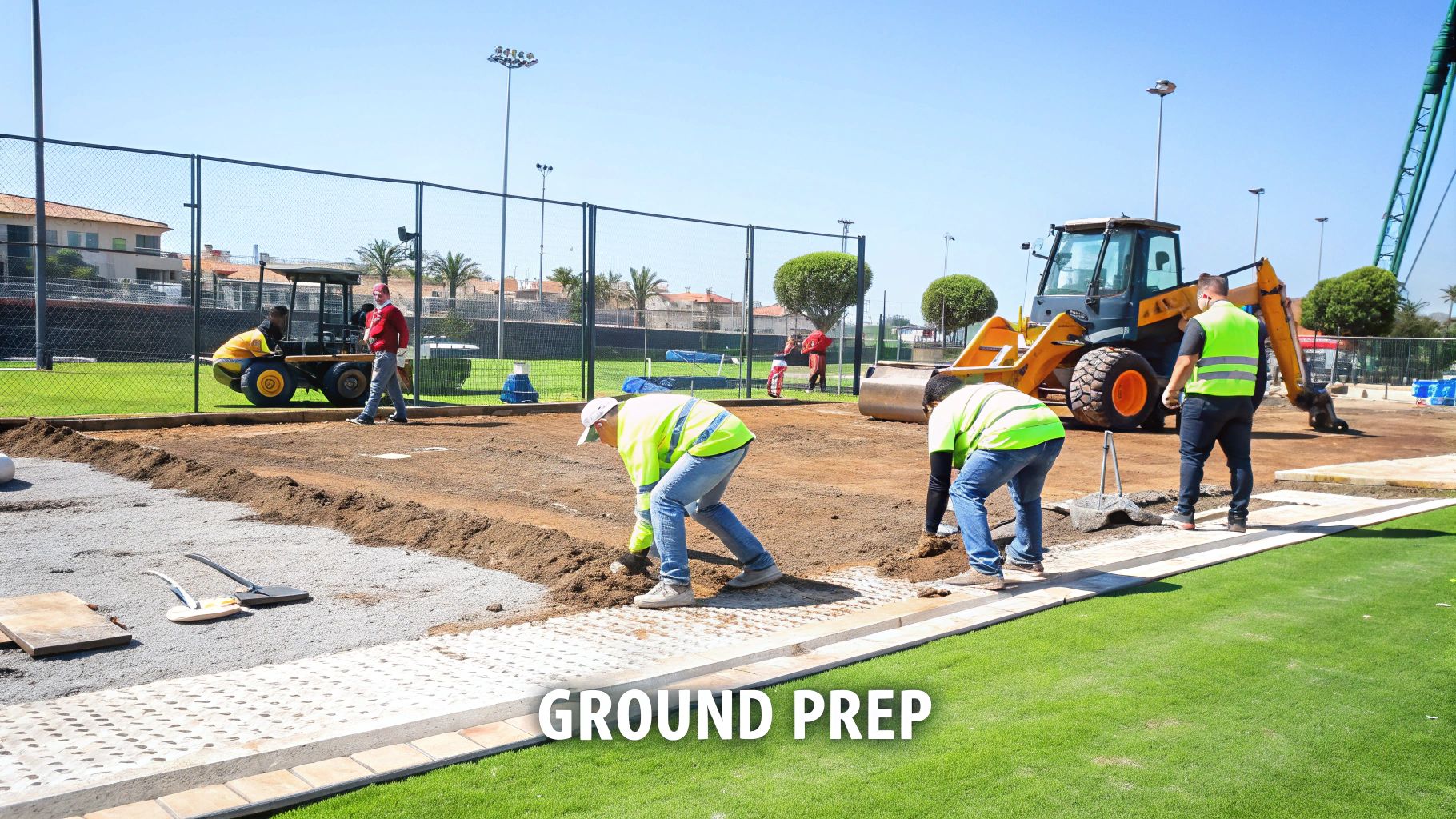
A truly great padel court isn't just a space to play; it's an experience defined by thoughtful design choices. The details you and your padel court builder settle on will directly impact everything from game dynamics to the long-term durability of your investment.
Getting these specifications right is what separates a standard court from a premium one that players will book time and time again. It all starts with the absolute basics: the court dimensions.
A regulation padel court is 20 meters long by 10 meters wide. This might seem straightforward, but strict adherence is non-negotiable. If you have any plans to host sanctioned tournaments or official league play, any deviation—however small—can make the court ineligible.
Choosing the Right Playing Surface
The turf underfoot is one of the biggest factors in how a court plays. It influences everything from ball speed and bounce consistency to player comfort and safety. Your two main options are generally monofilament and fibrillated artificial turf.
Monofilament turf is made of individual, standalone fibres. This structure helps the fibres stand up straighter, which can lead to a faster game and a very consistent ball bounce. It's often considered the premium choice for its durability and clean, professional look.
Fibrillated turf, on the other hand, uses wider fibres designed to split (or "fibrillate") with use. This creates a denser, more interwoven surface that can slow the game down a touch, making it a great option for clubs that cater to beginners or more recreational players.
The type and amount of sand infill are just as critical. The sand provides stability for the turf fibres, aids in drainage, and helps control the ball's speed. A pro builder will ensure the correct grade and quantity of silica sand is applied for peak performance.
The Structure: Glass Walls and Framing
The enclosure is what makes padel, well, padel. The materials used here are crucial for both safety and gameplay. Tempered glass is the industry standard, but its thickness really does make a difference.
- 10mm Glass: This is a common and perfectly fine option for many courts, especially for private use or clubs with a more recreational focus.
- 12mm Glass: This thicker option provides enhanced durability and a more solid, reliable rebound. For high-traffic clubs or facilities hosting competitive matches, the upgrade to 12mm glass is a smart investment.
Beyond just the glass, the court's structural design plays a huge role. A classic court uses multiple steel pillars to support the glass panels. The modern trend, however, is shifting decisively toward panoramic courts.
A panoramic design uses fewer, larger structural supports, usually just at the corners. This creates wide, uninterrupted glass spans that give spectators a spectacular viewing experience and players an open, airy feeling on the court.
If you're looking for inspiration on innovative court designs that blend aesthetics with function, you can explore the Padel X Project to see some excellent examples.
Essential Finishing Touches
There are a few elements that often get overlooked but can make or break the playing experience. A top-tier padel court builder will have these details on their radar from day one.
Proper drainage is absolutely essential for any outdoor court. A well-designed system, often integrated into the concrete slab foundation, stops water from pooling on the surface. This not only extends your court's playable hours after it rains but also protects the turf from long-term damage.
Finally, lighting is crucial if you want to maximize court usage into the evening. Modern LED lighting systems are the only way to go. They deliver bright, uniform illumination without the harsh glare that can disrupt play. The goal is simple: light the court so evenly that players never lose sight of the ball, no matter where it is.
Capitalizing on the American Padel Market
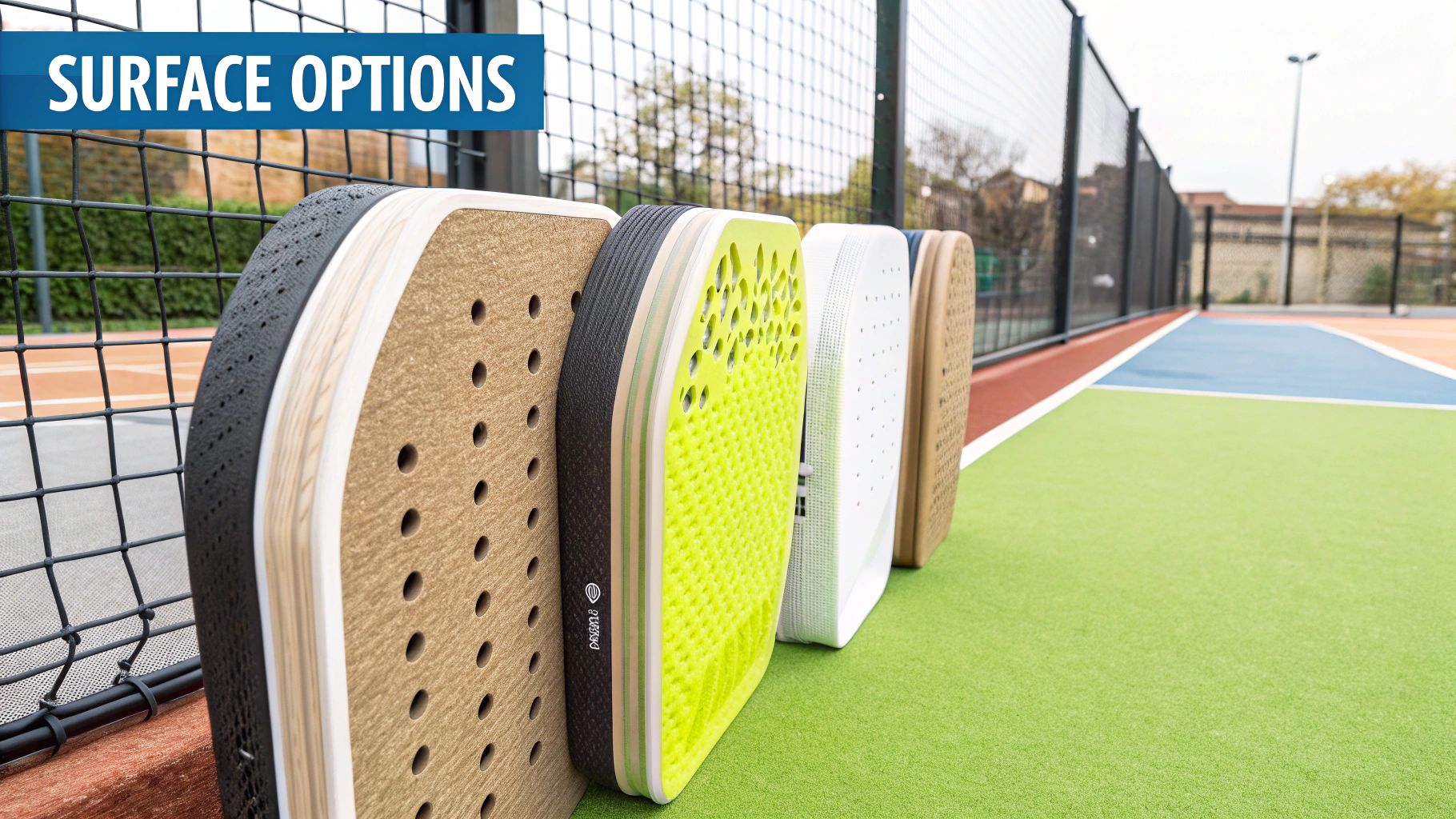
While padel has been a mainstay in Europe and Latin America for years, its next big frontier is, without a doubt, the United States. For anyone looking to invest or open a club, the American market is a ground-floor opportunity with some serious explosive potential. What we're seeing isn't just steady growth—it's a full-on surge that's changing local sports scenes almost overnight.
This boom is creating a huge demand for qualified padel court builders who really get the unique quirks of the U.S. market. The United States is on track to become a major player, with some projections showing the American padel market could blow past $500 million in the next few years. Fueling this is a massive wave of new players; the USA Padel Association has clocked a staggering 250% increase in active players since 2022. You can discover more about the projected U.S. padel boom and what's driving it.
Navigating U.S. Growth Hotspots and Challenges
Unlike established markets where the playbook is already written, the U.S. is a patchwork of different opportunities and obstacles. The growth isn't happening everywhere at once. It's concentrated in specific hotspots where the demographics, climate, and local culture are a perfect match for padel.
Cities like Miami, Austin, San Diego, and Los Angeles are really leading the way. These places have strong tennis communities, great weather for year-round outdoor play, and a population that loves to jump on new, social fitness trends.
But building in the U.S. brings its own set of headaches that you need to be smart about:
- Zoning and Permitting: This is probably the biggest hurdle. Navigating local building codes can be a nightmare. A court in Florida has to meet hurricane-related building codes, while one in California needs to account for specific seismic standards.
- Climate-Specific Materials: The sheer variety of American climates means you have to choose your materials wisely. A court in Arizona needs turf and steel that can bake in intense UV rays and heat. Meanwhile, a court up in the Northeast has to be tough enough to handle freeze-thaw cycles and heavy snow.
- Player Expectations: American players, many coming from tennis or pickleball, often have higher expectations for things like club amenities, online booking systems, and the overall feel of the facility.
Understanding these regional differences is everything. A successful U.S. project is never a one-size-fits-all job. It demands a builder who has boots-on-the-ground experience in that specific market and can head off local challenges before they turn into expensive problems.
Designing for the American Player
If you really want to cash in on this market, your facility has to be designed with the American player in mind. This goes way beyond just the court—it's about the entire club experience. American consumers expect quality and convenience.
Think about adding features that lean into the social side of the sport, because that's what's making it so popular here. Well-designed spectator areas, a comfortable lounge, or even a small café can turn a few courts into a buzzing community hub where people want to hang out.
Your padel court builder should be more of a consultant, helping you map out a facility that hits all these notes. By focusing on creating a top-notch, community-focused experience, you're setting your investment up for long-term success in one of the world's most exciting and fastest-growing padel markets.
Your Padel Court Construction Timeline and Process
Once you've shaken hands with your builder, the blueprint starts becoming a reality. Getting a handle on the construction timeline is absolutely critical for managing expectations, coordinating everything on your end, and making sure the build goes off without a hitch.
For a standard, single outdoor court, you're typically looking at a timeline of 4 to 8 weeks from the day they break ground to the final handover. That's assuming everything goes perfectly.
But let's be realistic—things happen. Tricky site access, troublesome soil that needs extra prep, or a solid week of rain can easily tack on more time. This is where solid communication with your builder becomes your best friend. A quick daily chat or weekly site walk-through can make all the difference in navigating those bumps in the road.
The Major Construction Phases
Building a padel court is a step-by-step process where each phase literally builds on the last. While every project has its own quirks, the fundamental workflow is pretty standard. Your builder will be running the show, but knowing the key milestones helps you follow along and ask the right questions.
Here’s a breakdown of what the journey usually looks like:
- Site Prep and Groundwork (1-2 weeks): This is where it all begins. The crew will clear the area, excavate to the right depth, and get the ground perfectly level. This is also when they'll install crucial drainage systems to keep water from becoming a long-term headache.
- Foundation and Curing (1-3 weeks): Next, they'll pour a reinforced concrete slab to create that rock-solid, flat base. This part requires patience. The concrete needs time to properly cure and gain its full strength before you can put any weight on it, so don't rush it.
- Structure and Glass Installation (1-2 weeks): With the foundation set, things start to move fast. The steel frame goes up, and suddenly it looks like a court. Then comes the careful work of installing the heavy tempered glass panels, which really starts to bring the space to life.
- Turf, Sand, and Lights (1 week): The final stretch. The artificial turf is rolled out, meticulously cut to size, and secured. After that, silica sand is brushed deep into the turf fibers for optimal play. The last major step is installing and testing the lighting system.
This infographic gives you a great visual of how these pieces fit together, from the dirt work all the way to the finished court.
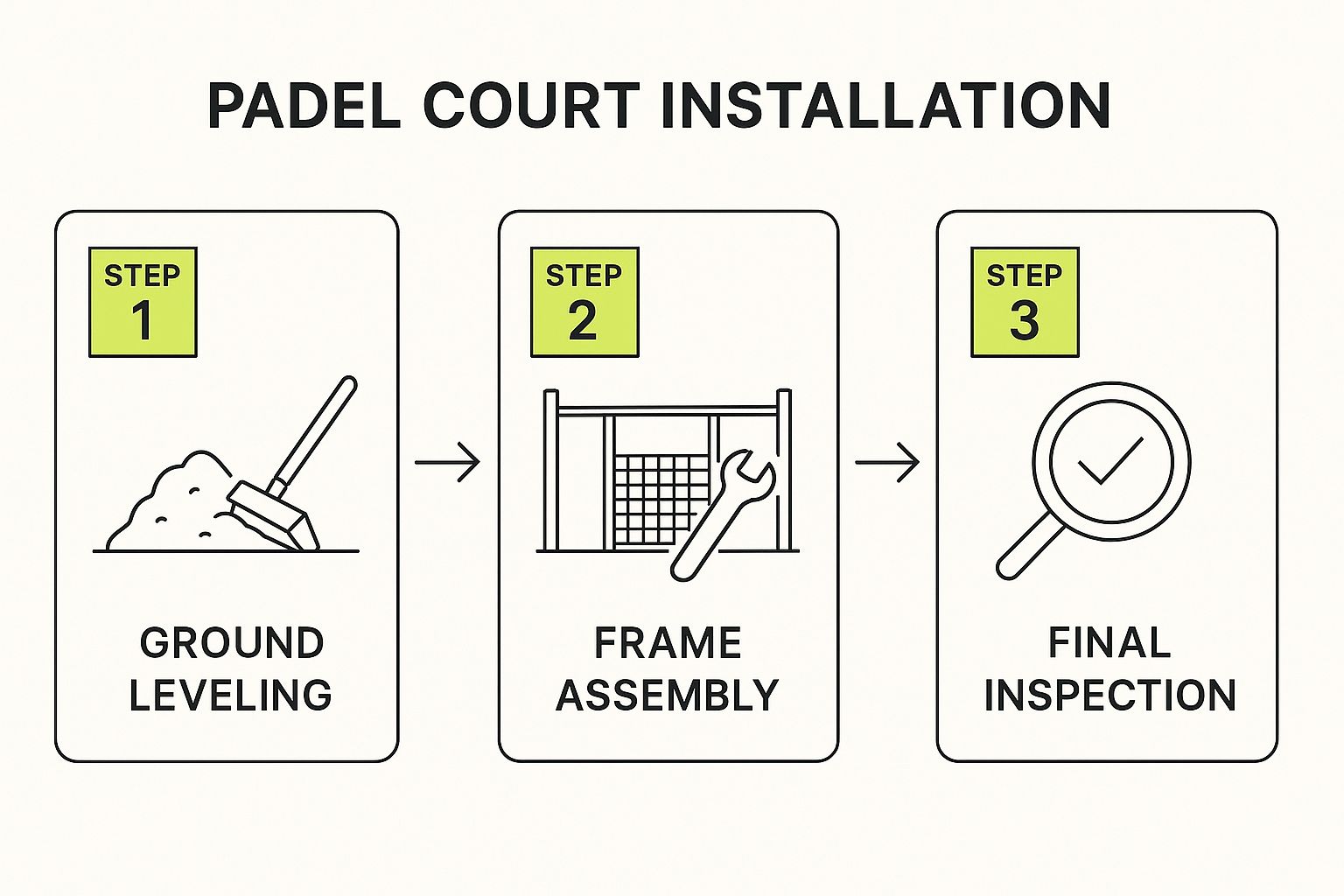
As you can see, it's a logical sequence designed to guarantee a high-quality, structurally sound court that's built to last.
Project Management and Communication
Pulling off a padel court build successfully requires a bit of expert project management in the construction industry to keep things running smoothly. You don't have to be a pro, but staying engaged is key. Regular check-ins with your project manager are non-negotiable. Set up a communication rhythm that works for both of you—maybe it's a daily text update or a formal site meeting every Friday—to stay on top of progress and any curveballs.
Being proactive with communication is the best way to stop small issues from snowballing. Don't be afraid to ask questions, track the milestones you've discussed, and make sure your payment schedule lines up with the work that's actually been completed.
Another thing to watch out for is "scope creep." It's easy to get excited and decide you want upgraded lights or extra benches halfway through. If you do, make sure you get a formal change order. This document should clearly lay out the new costs and any impact on the timeline, so there are no surprises for anyone.
For an even deeper dive into the entire building process, check out our complete guide to https://padelrumors.pages.dev/news/padel-court-construction/.
Common Questions About Building a Padel Court
Whenever someone decides to build a padel court, a flood of questions isn't far behind. That's completely normal. Getting clear answers upfront helps you feel confident and makes sure you and your padel court builders are on the same page.
Let's walk through some of the most common things people ask us.
How Much Space Do I Actually Need?
This is usually the first question out of the gate. A standard padel court playing area is 20 meters long by 10 meters wide. But you can't just stop there.
For safety and proper play, you need a runoff area around the perimeter. We always recommend at least one meter on all sides, which brings your minimum total footprint to about 22m x 12m. This gives players enough room to move without hitting a wall or fence on an out-of-court play.
What’s a Realistic Timeline?
Once you have the space figured out, the next thing everyone wants to know is how long it will all take. For a single outdoor court where the groundwork is already prepped, a good builder can get it done in about 4 to 8 weeks. Of course, things like bad weather, tricky site access, or custom design features can stretch that timeline out a bit.
Indoor vs. Outdoor: What's the Real Difference?
The basic structure is pretty much the same, but the environment changes everything. An indoor court means you can play all year round without worrying about rain or wind, which is a huge plus.
The main catch with indoor courts is ceiling height. You absolutely need enough room for lobs. We tell clients to aim for a minimum clear height of 7 meters—anything less, and you’ll find the game feels cramped and frustrating.
Choosing the right materials is one of those decisions that pays off for years. It's easy to get fixated on the initial price tag, but think about the long-term upkeep and, most importantly, the quality of play you're creating.
How Much Maintenance Are We Talking About?
A lot of people think padel courts are a "set it and forget it" deal. They're low-maintenance, for sure, but definitely not zero-maintenance. A little upkeep goes a long way.
Here are the key things you'll be doing:
- Weekly Brushing: You'll need to brush the artificial turf to keep the sand infill evenly distributed. This keeps the fibers standing tall and gives you a true, consistent ball bounce.
- Glass Cleaning: Simple but crucial. Clean glass is a must for good visibility and keeping players safe.
- Regular Inspections: Every so often, do a quick walkthrough. Check for loose bolts in the structure or any dings in the mesh. Catching these little things early prevents them from becoming bigger problems.
Do I Really Need a Padel-Specific Builder?
Yes. A thousand times, yes. A general contractor is great with concrete and steel, but they don't understand the nuance of padel.
A specialized padel court builder knows the exact tolerances, the best materials for bounce and durability, and the little details that separate a good court from a great one. Their expertise is genuinely worth its weight in gold.
At Padel Rumors, we're here to give you the insider knowledge you need for every part of your padel journey. From building a court from scratch to perfecting your vibora, check out our expert guides and gear reviews at https://padelrumors.pages.dev.


